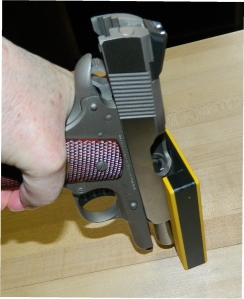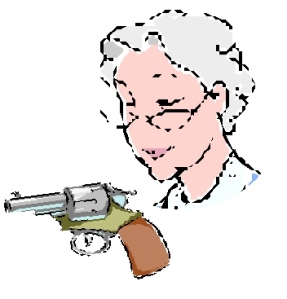 THE WHITE HAIRED SHOOTER
THE WHITE HAIRED SHOOTER
Today’s post discusses strengthening your hands, wrists and fore arms to prepare you for shooting a firearm and is a continuation of “Getting a GRIP” posted in February 2014, a brief excerpt:
“The strength of your grip on the gun is crucial when it comes to managing and controlling your aim while shooting. A weak grip will magnify the impact of recoil and the muzzle of the gun will jump more erratically. This makes “follow through” – which is part of maintaining a good grip following a shot and a big factor in your next shot, extremely challenging. Your hand will also tire more quickly – which cuts down on the amount of practice you want to endure, because it can also hurt! It is very possible that without an adequate grip you may also exacerbate problems you already experience with your hands, wrist and forearm.”
In that post I mentioned there are various types of equipment that can help increase your hand strength, and there is an enormous wealth of information available. But before we get into that, let’s look generally at what you do each day already.
The Mature Woman’s Daily Activities, and Strength and Flexibility
Whether you suffer from arthritis or some other serious medical condition or not, facts are women tend to have a weaker grip than most men, and older women have usually lost some hand strength as they have aged. It takes more regular effort and attention to maintain a healthy body that is flexible, strong and able to endure strenuous activities as we age. Our generation – the baby boomers – may have rewritten the book on elderly physical fitness, and if you frequent a gym, do “Curves” or other exercise programs, hooray! You are already well on your way to move into more specific exercise for your hands, wrists and forearms that will make you a great shooter!
But I’m “betting” that the average mature woman does not make working out and weight training the highest priority in her schedule. I know that I don’t. It is important, but time is filled with so many demands and so much variety, that often times I neglect working at staying strong and fit.
It is shocking to me how quickly muscle tone starts to decline when I have laid off exercising for what I would consider short periods – maybe a couple of weeks to a month. I get out of “training” usually because of travel, not feeling well, or a need to pay attention to something/somebody else that just “gobbles up” my time. And winter is the biggest challenge for me. We live in very hilly terrain, and the winter snow and ice and fewer daylight hours here in the Northwest take a huge toll on walking and hiking. That leaves me inside with its lowered activity levels.
If you are like me, many of the hours you used to spend in the kitchen kneading bread, hanging laundry to dry, carrying “tons” of grocery bags to feed the “hungry hordes” , and other weight bearing and hand strengthening activities have diminished or are things of the past. While I still garden, it is only seasonal exercise, and technology has provided new equipment that no longer has me wringing out mops manually or carting around very heavy vacuums. Progress and an “empty nest” has not served my hand strength well!
Without spending a lot of time at the gym or buying specific equipment, your daily life can provide lots of opportunity to exercise your hands, wrists and forearms. Dexterity can be increased and maintained with various craft activities including knitting and crotchet, embroidering, scrapbooking, gardening, and so on. Unfortunately, the activity I still engage in for the most hours: keyboarding/typing,does not increase my finger and wrist strength or flexibility.
All it takes to make quite a difference, is to spend just a few extra seconds (and repetitions) while you lift that big jug of whatever liquid you just bought at Costco; hold that cast iron pan out in front of you as though you were holding your gun for as long as can without shaking; wrap your hands around that soup can and do a curl or two as you walk from the pantry to the counter; and while you are vacuuming, change hands and redo that bit of the floor a little more than necessary! It doesn’t take much to start building strength.
I know my hands are stronger after just a remarkably short period of time when I make it part of my daily routine.
On Beyond the Dailies:
Developing shooting specific exercise regimens can make a huge difference in your shooting. Whether you intend to take up shooting as sport or rely on it for personal and home defense – particularly as you initially enter into shooting make some time to improve grip strength, endurance, and flexibility.
One of the recommended strengthening methods is to “Hold and Dry Fire” your gun, and that will be a subject of another post. But PLEASE USE:
* * * C * A * U * T * I * O * N * * * Please read before
DRY FIRING OR HOLDING A PISTOL for exercise.
Safety First.
Make this your Rule #1 Always assume a gun is loaded until you have checked it out.
I handle guns daily in our business, and EACH TIME I pick up one I check that it is clear and empty, even when I have set it down for a little while in between pictures. On a semi auto: drop the magazine, pull the slide back and inspect there is no bullet in the chamber or barrel. Some people advocate getting in the habit of using a finger to double check the chamber manually. On a revolver: Doubleaction: Swing out the cylinder, rotate the cylinder to check that there are no cartridges. SingleAction: Open the loading gate and rotate the cylinder to check that there are no cartridges.
Optional Rule #2 LOAD “snap caps” EACH TIME you are ready to practice holding and/or dry firing.
Snap caps – what they are, when they are mandatory, and where to get them – will be discussed more fully in a future “Dry Firing Your Handgun” post. But I suggest, especially for the “more mature” ladies, that adding in this step will doubly insure that you have no live ammunition in your gun when you are about to practice: whether holding your pistol for “weight training”, or dry firing it. I know at times I am more absent minded than I used to be, mostly because I am no longer REQUIRED to be on my toes 24/7 with kids – and have relaxed my work schedule, but also recognize it is a factor of my aging. While these golden years are very active, I sure don’t want to EVER have an accidental discharge because I failed to check my pistol. It is my opinion that by instilling the habit of loading in snap caps for dry firing, you are giving yourself just that little extra edge of attention to safety.
* * * * * * * * * * * * * * * * * * * * * * * * * * * * * * * * * * * * * * * * * *
Some ideas for exercising:
Some Quotes from a couple of “Forums” on the topic of strengthening your grip:
There are many wonderful sites and forums on line. You don’t have to be a member of a forum to browse there. Each major gun manufactured has a forum online, and shooting enthusiasts have created general and special topic threads as well. For starters, you can enter something like “strengthening exercises for shooting” in Bing, Google, Yahoo, Ask…. and you’ll discover many topic threads in many different forums.
Here are a few, mostly “older” quotes on the topic from the forum “The High Road” which is a marvelous resource and place to learn and share about responsible firearm ownership!
Falconeer January 23, 2006, 12:26 PM
I always found that, in the absence of actual trigger time, practicing holding the pistol on target would help.
Thanks for the idea. Is this something that would help even sitting down? It would be nice to watch a movie and work on it. I suspect it wouldn’t be quite as good as standing.
Pcf January 23, 2006, 12:27 PM
You can do these sitting or standing. Open your hand fingers spread apart, palm facing the deck, close palm into a fist, open hand again, repeat, do as quickly as possibly. Do 100 repitions
Jim Watson January 23, 2006, 11:33 AM
Dryfiring will train the exact muscles employed. Wrist weights and/or an old magazine poured full of lead will help as you get steadier.
mete January 23, 2006, 11:18 AM
You can get a grip strengthener or use a tennis ball.You can do that excercise with weights on your wrist too.
And an excerpt from “The Ruger Forum” – another great resource:
“When I first made the decision to start carrying I considered many guns and decided on carrying a revolver. I purchased a scandium Smith and Wesson J-frame. Very light and short which made for difficult mastery.
What I wasn’t aware of when I made my choice was the very hard triggers on J-frames.
Between light weight, small grip, short sighting radius, .357 magnum recoil, and the 18 pound double action trigger stoke on the gun when I first got it – I found it a very hard gun to master. I was determined to do so, however. I do pretty darn well now, if I do say so myself. I wouldn’t trade for anything.
One of the prime avenues to my success (along with a laser for dry fire practice at home) was working diligently on strengthening my forearms, my grip, and mostly my trigger finger strength.
I tried several finger strengthening devices and finally settled on a squeeze ball to go with my regular grip exerciser (which I shift around in my hand just as I do with the ball to exercise the fingers individually as well as general hand grip).
Within a few months my shooting improved 100%. Strengthening my trigger finger abilities was the prime help of all my chosen tools.
The LCP was a later purchase. So I don’t know that the improvement would have been as profound with just it as my gun. But there are several similarities between the LCP and a lightweight snub. They are both light weight, have short grips, and a very long hard trigger pull.
It seems to me that the same methods I used with great success for my snub training would be wise for new LCP owners to adopt. I highly recommend that new shooters increase their strength in the above areas (particularly the trigger finger stroke) to keep the gun from wandering around during the trigger stroke.”
Whatever method of strengthening you settle in on, start it as soon as you can. You don’t need a grand plan or well designed program to make improvements in your strength and dexterity. But you do have to DO IT!
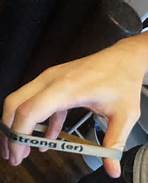
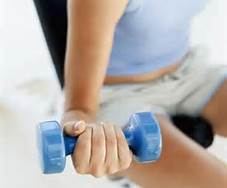
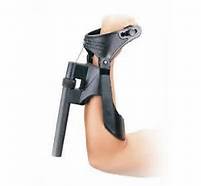
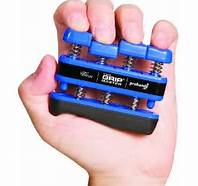
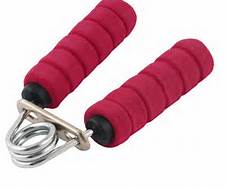
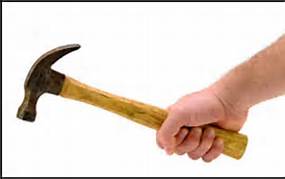
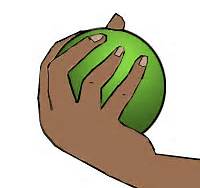
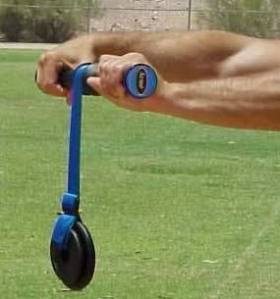
Happy and Safe Shooting!
— Peggy
 THE WHITE HAIRED SHOOTER
THE WHITE HAIRED SHOOTER